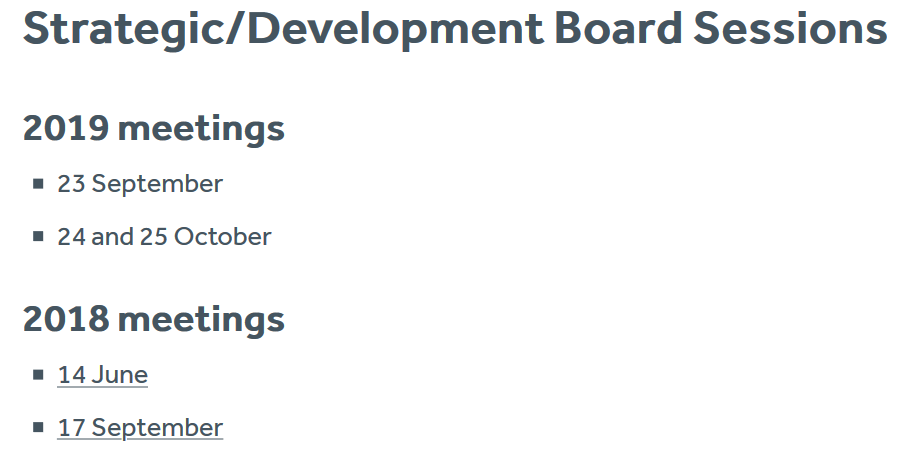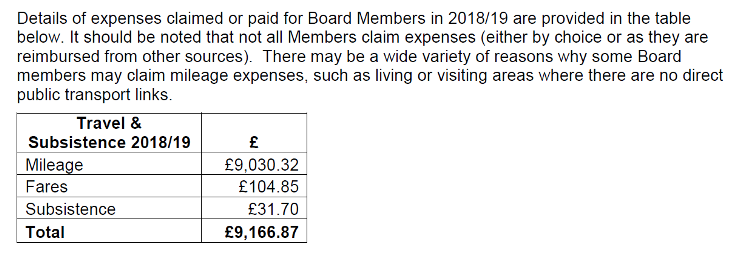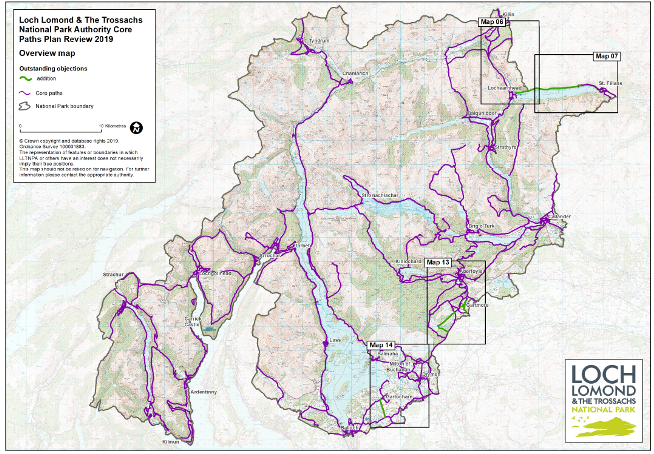
The Loch Lomond and Trossachs National Park Authority held its quarterly Board meeting last Thursday (see here) in Kinlochard Village Hall, in Strathard. Almost everything about the meeting, from the location to the agenda items to the discussion, illustrated complacency about the declaration of a climate emergency by the Scottish Government six months ago. The LLTNPA are far from being the only Public Authority which has been slow to respond but, being a National Park, with a legal duty to put conservation first, its reasonable to expect that they might have been at the forefront of addressing the Climate Emergency and leading by example.
Perhaps the LLTNPA’s “Strategic Development session” which, according to the LLTNPA website, was held in the afternoon and the next day was devoted to discussing what the Park should be doing? Unfortunately, at the time of writing, its impossible to tell (see screenshot above) although at the meeting there was a brief mention of a paper on the Climate Emergency being brought to the December meeting. Whatever the case, the meeting showed that the Board, which has strategic responsibility for the direction of the National Park, have a lot of thinking to do.
Location and travel
Kinlochard, if you don’t know it, is impossible to reach by Public Transport and Aberfoyle, four miles to the east, is not much better. So why was the Board Meeting held here apart from the views out across Loch Ard from the village hall? Not a single member of the local community was present.
Enabling local communities to witness Board discussions was used last year to justify the September Meeting being held at Brig O’Turk – where if my memory is right one member of the public was present. No its not that! If the LLTNPA Board really want to be open and transparent about what it does, it would webcast its meetings like Highland Council. It committed to do this, after public pressure, at the special Board Meeting which was due to decide the Flamingo Land Application. No sign of that at the Kinlochard Village Hall.
I try to travel to all the LLTNPA Board Meetings I report on by public transport. Using bike and public transport was something I committed to do when appointed to the Board of Scottish Natural Heritage almost 20 years ago – I thought the Board should lead by example. I used my car less than a handful times in three years on SNH business, all to get to remote locations. I was forced to do last Thursday too as were Board Members and associated staff. There were far too many cars for the car park, most like mine with only one person in.
Earlier this year, I thought it would be interesting after the Declaration of a Climate Emergency, to find out how Board Members get to meetings, including those held in the Park HQ at Balloch which is well served by public transport, and how senior staff get around. The initial response appeared on the Park website in August (see here)and was hard to decipher. I asked for a clarification and in early October received a very helpful reply FOI 2019 -018 Response and FOI 2019-018 response Appendix A which included this:

According to Scottish Government data, transport accounted for 34.2% of Scotland’s carbon emissions in 2016. We need a fundamental shift towards public transport if we are to reduce them. If you want to understand why the LLTNPA have been almost completely silent on this issue, just look at their expenses claims. I have never seen any Board Member arrive by bike to a Board Meeting in which case the information shows almost 99% of those members who make travel claims travel by car. Until the Board are forced to change their own behaviour, they are unlikely to address the issue of transport and carbon emissions.
This creates a tricky challenge for the Park’s Director of Conservation, Simon Jones, who in a news piece for Climate Change week wrote (see here) about the transport challenge in the National Park:
“Of course, at the same time [as supporting local communities to act] we have to be mindful of the fact that the National Park is a place that emits a huge amount of carbon through the volume of visitors travelling to, from and through the area by petrol and diesel vehicles.
That’s a huge challenge, but as an organisation we don’t shy away from encouraging responsible visitor behaviour when it has a significant impact on the environment. And it’s not just about the climate, the increasing number of vehicles has an impact on roads, local communities and the visitor experience.
But making a shift to fewer car journeys is a long road. While we encourage people to use more sustainable ways to travel such as public transport or choosing active travel like cycling, we know that the options need to be available for people to make those positive choices. Working with partners to improve infrastructure and public transport links as well as providing the right information and access to active travel options will be a key part of our work in the next few years.”
I would suggest the LLTNPA need to start not with visitors but their own Board and senior management and to start showing a bit of leadership instead of hyprocrisy.
The Youth Committee and the transport challenge
The LLTNPA has now set up a youth committee of young people. A number of them were at the meeting for a discussion on the pledge the Park has made to work with Young People as part of the UK wide “Iwill” campaign (see here). Leaving aside scepticisim about the LLTNPA’s motives – they have a history of cutting off engagement with any group or person who disagrees with them – and the lack of transparency around the set-up of the Youth Committee (there is NOTHING on the website about who young people should contact if they want to get involved (see here)) – the young people present were articulate and one of their key messages was BUSES! Or the lack of public transport for young people living or visiting the National Park and how this impacts on their lives. This is something which makes many young people want to leave the National Park and has contributed to the fall in population over the last ten years.
For most of the young people it was their first Board Meeting. They were too polite to point out that they had had to be transported to Kinlochard by a LLTNPA minibus while Board Members had arrived by car. Perhaps the Park should be putting their minibuses at the disposal of young people seven days a week?! I rather hope that in the spirit of Extinction Rebellion – there was amazingly no this at the meeting – that the Youth Committee challenges Board Members to give up their cars for Board business. That would force them to confront the very real challenges of how we create sustainable transport systems in the countryside. Imagine for example if the local members for the Breadalbane or the Trossachs areas had to get to meetings by bus or train? The frustrations and difficulties would focus minds on what needs to be done to address the Climate Emergency.
The Board and climate change precipitated destruction in the Trossachs
Following my visit after the Board Meeting to look at landslips around Strathard (see here), I have learned more about the landslips around Loch Katrine. Several houses have been destroyed/made unsafe to live in, the road is still unsafe with masses of unstable material threatening it and local tourism businesses have been seriously affected as a consequence. I wish I had managed to visit. What is amazing, however, is the way the LLTNPA appears to have been ignoring what happened. Given the extent of the damage on land held in public authority ownership, its highly ironic that Simon Jones’s blog on climate change (link above) which referred to the flood damage was headed “If we invest in nature now, it will look after us forever”.
The LLTNPA, however, appears so far to have been completely silent on the disaster at the head of Glen Gyle and, while Scottish Water has got on with trying to repair the damage, has been notable for its absence. Where has the LLTNPA, which claims to put local communities first, been when one small local community in the heart of the National Park has been almost destroyed by a natural disaster? There might have been a rationale for meeting in Kinlochard if had been linked to a visit to view the damage but the secret meeting after lunch continued in the village hall.
Climate change and the Trees and Woodland Strategy
There was some discussion at the meeting about the role of Trees and Woodland in mitigating water run-off from the hills (see here), even if an opportunity for Board Member to view the issues on the ground was missed. There were also a number of Board Members who made excellent critical comments about the Trees and Woodland Strategy:
- David Cowan, asked how the strategy will achieve its objectives and landowners persuaded to do the right thing without resources?
- Martin Earl asked a related question about the aspiration to remove invasive non-native species and how this would happen when there was almost no funding to do this at present.
- Martin Earl also had concerns about the aspiration for local communities to manage community woodlands – which in part relates to how they access resources to do this.
- Ronnie Erskine struggled to see “the wood for the trees” (his words) and asked what the top three things were that would be changed as a result of this Strategy?
- Ellen Morton, to her absolute credit, had read the 21 responses to the strategy, and asked the question what the LLTNPA had actually changed as a result of the consultation. She couldn’t see anything and thought this was a major issue. This of course has been a problem ever since the camping byelaws, where the LLTNPA simply dismissed all the criticisms and carried on with what it had already secretly decided to do anyway. No-one picked up on the discussion with the Youth Committee in the morning where James Stuart, the Convener, had told the Young People present he was not interested in token consultation as it deters people from being involved. That’s exactly why there were only 21 responses to this “Strategy” which should be central to what the National Park does.
- Cllr Morton then nicely summed up the Strategy – and I noted her words exactly – “its pleasant [she said just before this there was hardly a word she could disagree with], its innocuous and its not clear at the end of it what the outcomes will be”.
Staff, to be fair, in responding to these points made it clear that despite the name, its not really a strategy at all but a guidance document. Its not designed to change anything. Deliberately so as that would mean challenging Forestry Scotland and Forest and Land Scotland and how they continue to mis-manage much of their land in the National Park. Instead it will help guide staff who have to comment on various forestry schemes, almost all of which depend on Forestry Scotland for funding. Very useful for the staff involved but that will not change anything.
The problem in part is the guidance is, despite many good things in it, not fit for a National Park. Amazingly, for example, given forestry is now fully under control of the Scottish Parliament, it promotes the UK Forestry Standard. This applies the same standards to National Parks as anywhere else (hence, for example, all the wide ugly poorly constructed forest tracks scarring the landscape). The Strategyt will also do nothing or very little to prevent further climate change precipitated environmental disasters.
Having raised many of the right questions, the Board approved the Strategy as presented with only one change, a minor mention of resource issues. Had they been taken to view the nearby environmental disaster around Loch Katrine maybe they would have been braver? Perhaps, Mairi Gougeon, the Environment Minister who will launch the strategy next month, could be invited by what remains of the local community in Glen Gyle to do so there?
The revised core paths plan
The last major item on the Board agenda was an update report on the core paths plan and how disputed changes were due to go to public inquiry (see here for links to blogs).The whole process is very legalistic and very time-consuming for the Access Team and I don’t doubt the staff concerned have worked very hard.
There was not one question from Board Members, however, on whether the proposed network is sufficient now there is a climate emergency? What, for example should be the role of core paths in enabling a shift in transport from car to public transport, cycling and walking (as advocated by Simon Jones in his blog piece?).
The proposed additions to the core path network are relatively few and leave an unjoined up path network as can be seen from the map presented to the Board:

This lack of ambition goes back over two years to when the LLTNPA, almost certainly for resource issues, decided to adopt the same criteria for new core paths as when it developed the first core path plan. The first core path plans were only intended as a first step towards improving path networks in Scotland but by sticking to the same criteria effectively that process has come to a halt. The explanation almost certain lies in resource issues, there is almost no public money to build new paths in the countryside and instead any paths that now get built are dependant on resources like lottery funding. That is something that needs to change with the declaration of a Climate Emergency.
Its worht noting that there is nothing to stop the LLTNPA from developing new path proposals outside the framework of the Core Paths Plan. They should now do so as part of a long list of actions needed to address the Climate Emergency.
Where next?
I hope this post has shown that the LLTNPA now needs to re-think fundamentally how it is operating as a result of the Declaration of a Climate Emergency. While its disappointing they have not so far done so I hope, if the Climate Emergency is discussed at their next meeting, Board Members will use that to initiate a far-reaching programme of change. It would do no harm, however, if Extinction Rebellion started to organise protests at Public Authority Board meetings about the lack of action – it might help concentrate minds.
Perhaps LL&TNPA are listening after all? Or was the following a one off practice prior to the cancelled Flamingoland hearing in the hope that a mass public turnout would be avoided? National Park Authority Planning & Access Committee Meeting Draft Minutes of Meeting held on 26 th August 2019, 13:30hrs John Muir Suite, Carrochan, Carrochan Road, Balloch
Item 1 Welcome and Apologies. The Chair welcomed those present to the meeting. The Chair advised that the meeting would be recorded to test potential webcasting equipment although the recording of the meeting would not be publically broadcast.